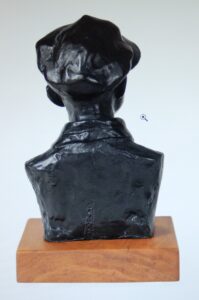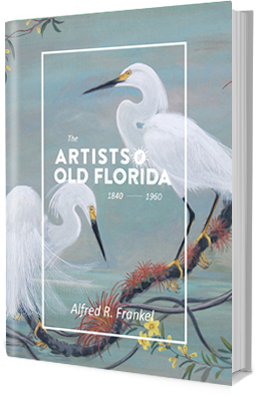Savage, Augusta, Jacksonville, West Palm Beach, Gamin, signed on front, signed Savage on rear. Bronze with black patina, 1929, year of original design, later cast. 8 1/2 by 5 by 4 inches, (bronze), 6 by 6 by 1/2 inches, (base).
Augusta Savage was an American sculptor and educator who battled racism to secure a place for blacks in the American art world. She became one of the most influential artists of the Harlem Renaissance. Born Augusta Christine Fells, in Green Cove Springs, near Jacksonville, in 1892, she was the seventh of fourteen children. Augusta moved with her family to West Palm Beach in 1907. Here she taught art for a dollar a day while still a student in high school. She left home in 1915 to enroll at the Tallahassee State Normal School, later Florida A. & M. In Jacksonville Augusta did commissioned busts of wealthy black clients. She moved to New York City in 1921 and enrolled at Cooper Union. Extremely poor, she was given a scholarship by her teachers. That year Augusta was denied a place in a summer art program at Fontainebleau, near Paris, France because of race. She married James Savage and started working in a steam laundry to earn money for study in Europe. Now Augusta Savage, she received commissions for portrait busts of W. E. B. DuBois and Marcus Garvey. Author DuBois and two Rosenwald Grants helped her study in Paris from 1929 to 1931. Returned to New York in 1932, Savage founded her own school, the Savage School of Arts and Crafts, in Harlem. Her students included Jacob Lawrence, Norman Lewis, and William Artis. In 1936 Savage was assistant supervisor of the Works Project Administration (WPA) of the Federal Art Project, in New York City. Jacob Lawrence credited her with getting him involved with the WPA. Later she founded, and was first director of the Harlem Community Art Center, which played an important role in developing many young African American artists. She insisted it be staffed with black artists. Savage worked in bronze, clay, and plaster, which was then painted to look like bronze. She is known for her small, sensitive, sculpture portraits of prominent members of the Harlem community and later for her focus on ordinary black American’s. Savage, with Aaron Douglas, co-founded the Vanguard as a meeting place for Harlem Renaissance intellectuals. Later in life, unable to secure commissions and unemployed, she moved to Saugerties, New York to try writing. She died in New York City in 1962. Membership: National Association of Women Painters and Sculptors. Born: February 29, 1892, Green Cove Springs. Died: March 26, 1962, New York City. Education: Florida Agricultural & Mechanical; Cooper Union, 1921; Academie de la Grande Chaumiere, Paris; with Felix Beneteau. Exhibits: New York Public Library; Grand Chaumiere, Paris; Grand Palais, Paris. Source: Charlotte Streifer Rubinstein, American Women Artists, 258-260. Leslie King-Hammond, Augusta Savage. St. James Guide to Black Artists, 470-472.





